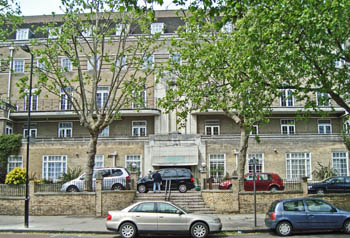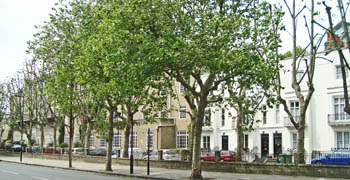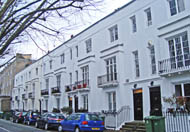General, chronic
In the 14th year of its establishment, in March 1907, the Institute of Trained Nurses of the order of Our Lady of Consolation secured two private houses in Barkham Terrace - No. 60 and No. 80 Lambeth Road - for use as a hospital.
The 3-storey terrace of 18 houses, owned by the Bethlem Trustees, was located opposite the grounds of Bethlem Hospital (the grounds later became a public park). The terrace was set back from Lambeth Road, with a driveway parallel to the road and a lodge at each end. It was divided in the middle by the Upton Baptist Chapel, which opened in 1862 and could seat 700 people.
The Catholic Nursing Institute was officially opened on 23rd May 1907 by the Bishop of Southwark. It had two distinct parts - the District Nursing side, located on the eastern side of the terrace at No. 60, which also had 4 beds for those needing rest only, and the hospital side on the western side at No. 80, which had 12 beds for middle-class patients of all denominations who were unable to pay the fees charged by nursing homes, but were not suitable for public hospitals.
By the 1920s the hospital part occupied two of the houses in Barkham Terrace, which intercommunicated on each floor. Electrical lighting and bathrooms had been installed. Ordinary patients paid 1 guinea (£1.05) a week, while private patients paid 2 gns (£2.10).
In 1929, following a mortgage arrangement of £20,000 at 5.5% with the Bethlem Trustees, the freehold site of all 18 houses was purchased for £30,000 (the Baptist chapel was not included), together with the lodges and the drive. By this time the hospital part occupied three houses in the Terrace. Patients were charged 2 gns (£2.10) a week to stay in a 2- or 3-bedded ward; private patients paid 4 gns (£4.20) a week for a single room.
In September 1932 the hospital part was extended when another of the houses became vacant; this increased the bed complement from 16 to 24 (including the 4 beds at No. 60). The Institute then occupied four houses in Barkham Terrace, including No. 60, with the others still let to tenants.
The 8 new beds were intended for patients with inoperable cancer and for other long-term cases. The basement of the house became a service kitchen and a dining room - 12' by 11' (3 m x 2.8 m) - for 3 probationers and 2 night nurses. The ground floor contained two single bed wards - one measuring 10' by 11' (2.5 m x 2.8 m) and the other 12' by 14' (3 m x 3.6 m) - and a Nurses' Day Room. On the first floor were a single-bed ward and a 3-bedded ward, a bathroom and WC. The top floor contained a 2-bedded ward and a Staff Room. Patients in single rooms were charged 3 gns (£3.15) a week, while those in other wards paid 2 gns (£2.10).
In 1934 the operating theatre on the first floor was extended by 5' (1.6 m) from its original size of 11' by 7' (2.8 m x 1.8 m) at a cost of £305. Part of the extension contained a sterilising room.
In 1937 a proposal was made to extend the hospital side to 50 beds (that is, 20 ordinary beds and 30 for private patients). It was planned to eventally make the 9 houses on the western half of the Terrace into a hospital with 100 beds, and to use the eastern half as a Nurses' Home. It was also hoped eventually to purchase the Chapel in the centre of the Terrace.
In 1939 the western side of Barkham Terrace was demolished and the hospital completely rebuilt in 1940. It had 47 beds.
During WW2 the Institute joined the Emergency Medical Scheme, with 21 of its beds under the control of St Thomas' Hospital. However, in September 1940 a high explosive bomb demolished half the building, including the surgical block, to ground floor level (the Chapel in the centre of the Terrace was also severely damaged).
After the war the Instiute made a small number of beds available to the Metropolitan Ear Nose and Throat Hospital, whose premises had been completely destroyed by bombs.
In 1948 the Institute was disclaimed from the provisions of the National Health Service Act, 1946, and did not join the NHS.
Difficulties in obtaining a license from the Ministry of Health to rebuild the hospital greatly delayed the project but, in 1951, the Institute was granted £48,000 from the War Damage Commission, and rebuilding work began. The 70-bedded hospital was completed in December 1952.
In 1959 the Hospital had 72 beds. The weekly cost of an in-patient was £12 6s 10d (£12.34).
A secondhand X-ray apparatus was installed in 1959. It was used for plain films and barium studies on in-patients only. One of the Sisters was sent to the School of Radiography at the Middlesex Hospital to train as a radiographer.
In 1960 the Institute was an independent medical and surgical nursing home with 53 beds - 23 in single rooms (all with telephone, radio and TV, and en-suite bathrooms), 18 in small wards (one ward had 6 beds for female geriatric patients) and a children's ward of 10 beds. A large proportion of the patients were orthopaedic cases undergoing hip replacement, carried out by a consultant orthopaedic surgeon from the London Hospital. Patients in the children's ward were mainly tonsillectomy cases.
Ordinary patients paid 12 gns (£12.60) a week, while private patients paid 16 gns (£16.80) (those in a room with en-suite bathroom paid 22 gns (£23.10) a week), and children 8 gns (£8.40). (In 1959, of the patients treated, 156 were Catholic and 522 non-Catholic). There was an an operating theatre with an anaesthetic room, and a second smaller theatre. It was also intended to build a pathology laboratory next to the X-ray Department, as well as consulting rooms and a doctor's residence.
The annexe at No. 60 was still the centre of the District Nursing service provided by the Sisters for south east London. (In 1959 there were up to 12,400 out-patient attendences at the hospital and at patients' homes). The annexe also had 11 rooms of varying size and amenities for chronically ill patients. A large room cost 14 gns (£14.70) a week, a small one 8 gns (£8.40) and a bed in a shared ward from 5 to 7 gns (£5.25 to £7.35) a week.
The nursing staff comprised 23 Sisters of the order of Our Lady of Consolation, 13 of whom were qualified State Registered Nurses (SRNs). The unqualified Sisters undertook domestic work, such as cooking, cleaning and sewing, with the help of lay workers. Four of the SRNs worked as District Nurses and home helps.
In 1961 the Institute's premises - St Raphael's Home - in Bromley were extended to house 10 elderly infirm female patients.
By 1970 the Institute had 30 beds open, perhaps reflecting a lack of novitiates joining the order of Our Lady of Consolation. However, by 1980, 47 beds were open.
The Institute closed in 1984.
Present status (January 2011)
In 1985 the building became the Gainsborough Nursing Home, for short- and long-term care of the elderly.
It then became the Churchill London Clinic, a psychiatric hospital with 68 beds, managed by Covenant Heathcare Ltd. It provided acute and intensive care, and rehabilitation services for mental patients. It also incorporated Transform and various clinics and advice centres.
In 2009 it was bought by the Campian Group for an undisclosed sum. It is currently closed and undergoing refurbishment and is due to re-open as a mental health rehabilitation hospital early in 2011.

The former Catholic Nursing Institute at the western end of Barkham Terrace.

The cross above the canopy over the main entrance.

Barkham Terrace was built in 1842 and named after Edward Barkham, an 18th century benefactor of Bethlem Hospital. Only the eastern part of the original building, faced in stucco, remains.


The hospital part was on the western side, now completely rebuilt (left), and the District Nursing part on the eastern side (right). The remaining houses have been renumbered as if in Barkham Terrace rather than in Lambeth Road (Nos. 56-72 Lambeth Road are now Nos. 4-20 Barkham Terrace). Thus the original No. 60 Lambeth Road is now No. 8 Barkham Terrace.

The lodge at the eastern side of the terrace is now No. 2 Barkham Terrace. The western lodge has been demolished.
(Author unstated) 1911 (Untitled). British Medical Journal 2 (2650), 874.
(Author unstated) 1915 Nursing Echoes. British Journal of Nursing, 10th July, 39.
http://hansard.millbanksystems.com
www.bethlemheritage.org.uk
www.british-history.ac.uk
www.geograph.org.uk
Return to home page